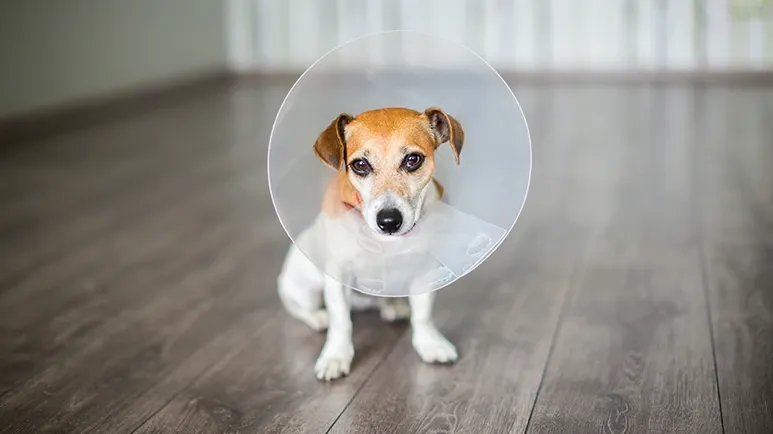Snip Now or Later? What Most Pet Parents Don't Realize
Is spaying or neutering always the right choice? New research shows it's not that simple — and your dog's long-term health may depend on it.

STORY AT-A-GLANCE
- New studies reveal neutering nearly doubles the risk of obesity in dogs, especially males, by disrupting hormones that regulate metabolism, muscle tone, and appetite
- Small and toy breeds are most prone to post-neuter weight gain, while large breeds face added risks if surgery occurs too early or too late in development
- Neutering's hormonal changes can lead to joint disease, incontinence, and certain cancers, showing that "routine" sterilization has more profound long-term health effects than once believed
- Your habits matter too. Dogs with overweight owners or those given treats too often face higher obesity risks. This shows the strong connection between human and pet health
- Safer alternatives like vasectomy, ovary-sparing spay, or chemical castration preserve natural hormones and protect health while still preventing unwanted litters
For decades, you've probably heard that getting your dog "fixed" is the responsible thing to do. It prevents unwanted litters, keeps male dogs from roaming, and supposedly makes your pet calmer and healthier. But in recent years, new research is challenging those long-held beliefs — especially when it comes to your dog's long-term health.
While spaying and neutering can prevent pregnancy and certain reproductive cancers, they also change your dog's metabolism, hormone balance, and risk for several chronic diseases. And one of the most significant and most overlooked side effects is obesity.
The Neutering Myth — 'It's Just the Responsible Thing to Do'
For years, neutering has been presented as both a moral duty and a medical necessity. In many countries, it's even a condition for adopting a dog. The logic seemed simple — no reproductive organs, no unwanted puppies, fewer hormone-driven behaviors, and lower risks of certain diseases.
But this traditional view leaves out one important truth — Removing your dog's reproductive organs also eliminates the natural hormones that help regulate weight, muscle tone, bone growth, and even mood.
A growing number of veterinarians now argue that neutering should not be automatic. Instead, it should be a personal decision made after weighing the risks and benefits for your dog's gender, breed, and age.
Hormones Matter More Than You Think
Hormones like estrogen and testosterone do much more than control reproduction. They also affect your dog's metabolism. When these hormones are removed through surgery, the body's "energy thermostat" changes.
That's why dogs often gain weight after being neutered, even when their diet and activity level stay the same. According to a large Banfield Pet Hospital study covering over 150,000 dogs, neutered dogs were almost twice as likely to become overweight or obese as intact dogs. The risk was even higher in males than in females of the same age and size.1
In other words, neutering doesn't just change your dog's ability to reproduce; it changes how their body works.
The Domino Effect of Weight Gain
A few extra pounds might not seem like a big deal. But obesity in dogs isn't just about looks — it's a gateway to serious health issues.
When your dog gains excess weight, it strains the joints, heart, and organs. It increases the risk of diabetes, arthritis, and certain cancers. Obesity also shortens lifespan and reduces quality of life, often turning daily walks and playtime into struggles.
A 2019 Danish study published in the journal of Preventive Veterinary Medicine found that 20.5% of dogs examined were overweight or obese, and neuter status was the strongest predictor in male dogs. Interestingly, neutering did not affect female dogs in the same way, suggesting that male dogs are more sensitive to hormonal changes following surgery.2
This difference may be due to testosterone's role in maintaining lean muscle mass and regulating appetite. Without it, male dogs' metabolism slows, and their natural energy balance shifts toward storing fat.
The Owner Connection — It's Not Just About the Dog
The study uncovered another fascinating link — your own lifestyle matters, too. Dogs with overweight owners were significantly more likely to be overweight themselves.3
In households where owners fed treats often or provided only one large meal a day, the risk of obesity increased further. This finding supports what veterinarians frequently call the "One Health perspective" — the idea that your health and habits directly influence your pet's.
So, if your dog is gaining weight after neutering, it's not just biology at play. Feeding patterns, exercise habits, and even your own health behaviors can compound the effect.
Why Spaying and Neutering Affect Weight Differently
While both sexes can gain weight after sterilization, males appear to be more vulnerable. In the Banfield study, standard-size male dogs neutered at 1 year old were 2.62 times more likely to become obese than their intact counterparts, while females were 1.53 times more likely.4
This difference may stem from how male and female hormones interact with metabolism. Testosterone helps build lean muscle, which burns more calories even at rest, while estrogen helps regulate appetite and fat distribution in females.
Removing these hormones disrupts both systems, but the impact tends to be more severe in males, who experience a sharper drop in metabolic rate.
Breed and Size — Why 'One Age Fits All' Doesn't Work
Another critical insight from the research is that size and breed make a big difference in how a dog responds to neutering.
The Banfield study divided dogs into five size categories, from toy breeds to giants, and found that toy and small dogs were at the highest risk of becoming overweight after surgery, followed by large breeds. Medium dogs had somewhat lower risk, while giant breeds were least affected.
However, the relationship wasn't linear or predictable. In other words, the "right" time to neuter — or whether to neuter at all — depends heavily on your dog's breed, body type, and genetic makeup.5
According to an article published in Vet Help Direct, both large breeds neutered too early or too late have an increased risk of obesity. The safest window appeared to be during young adulthood — after puberty but before middle age. For small breeds, timing didn't seem to make as much difference, but the risk of obesity remained elevated regardless.6
The takeaway? Blanket recommendations simply don't work. Every dog's hormonal profile, metabolism, and growth pattern is unique, and so should your decision about sterilization.
Other Risks Beyond Weight Gain
Weight gain is only part of the story. Research has linked early or unnecessary neutering to a range of other health problems, including:7
- Joint and bone disorders — Removing sex hormones too early can interfere with bone growth, leading to hip dysplasia or cruciate ligament tears, especially in large breeds.
- Certain cancers — Paradoxically, while spaying prevents uterine and ovarian cancers, it may increase the risk of others, like hemangiosarcoma and bone cancer, depending on the breed.
- Urinary incontinence — Female dogs rely on estrogen for proper bladder control. After spaying, especially early in life, some females develop leakage problems later on.
- Behavioral changes — Not all behavioral effects are positive. While aggression linked to testosterone may decline, confidence and sociability can drop, too, particularly in nervous or anxious males.
These risks highlight why neutering should never be a routine procedure. Instead, it's a lifelong decision that needs to fit your dog's individual health, environment, and temperament.
Alternatives to Traditional Neutering
You might be surprised to learn that sterilization doesn't always have to mean removing reproductive organs. Other options can prevent unwanted litters without eliminating essential hormones.8
- Vasectomy (for males) — This surgery prevents sperm from traveling to the outside world but leaves the testicles intact. Your dog stays infertile but continues producing testosterone naturally.
- Ovary-sparing spay (for females) — This removes the uterus but leaves the ovaries, so your dog won't go into heat or get pregnant, but her hormonal balance remains.
- Chemical castration — This is a temporary implant that blocks testosterone production for six to 12 months. Once removed or expired, fertility and hormones return to normal.
These alternatives let you control reproduction while maintaining natural hormone function, offering the best of both worlds.
Why Timing Matters
If you decide to neuter, timing is one of the most important factors to consider. The studies show that age at sterilization significantly affects the risk of obesity and other long-term effects.9,10
- Before 6 months — Increased risk of joint disease and certain cancers in large breeds.
- Around 1 year — Often the lowest risk period for obesity and joint issues.
- After 3 years — Risks begin to rise again as metabolism naturally slows with age.
Because dogs mature at different rates, a 1-year-old Great Dane is not the same as a 1-year-old Chihuahua. That's why it's vital to ask your vet for advice. They can assess bone development, temperament, and health risks to guide the timing decision.
Managing the Post-Neuter Weight Risk
If you've already had your dog neutered, don't panic. There's a lot you can do to prevent weight gain and protect your dog's health.
- Adjust the diet immediately — Neutering reduces your dog's calorie needs by as much as 20%. Ideally, it's best to cut your dog's daily food intake by 10% to 20% right after surgery.11 Start small, monitor weight weekly, and adjust as needed. Remember, it's easier to prevent weight gain than to reverse it later.
- Reconsider treats — Treats are love, but too much love adds up quickly. In the Danish study, giving treats "during relaxation time" was linked to a higher risk of obesity, especially among owners who were overweight.12 Choose healthier options, such as small carrot slices or freeze-dried meat bits, and use them sparingly.
- Keep moving — Exercise is vital for metabolism and joint health. Daily walks, play sessions, or even short fetch sessions help keep calories in check. Interestingly, the Danish study found that even increased walking didn't offset obesity risk when the owner was overweight, suggesting that consistent, mindful activity for both the pet and the person is key.
- Regular weigh-ins — Most dogs gain weight gradually, so you might not notice it until it's a problem. Weigh your dog monthly, and check their body condition — you should be able to feel the ribs easily, but not see them protrude. A small change early can prevent long-term damage later.
Beyond Weight — The Bigger Picture
The push for routine sterilization often comes from well-meaning efforts to control pet overpopulation, and that's a real issue. But with modern pet ownership practices, improved identification, and accessible contraceptive alternatives, many experts now believe it's time for a more balanced approach.
When you choose whether or not to spay or neuter, you're not just making a reproductive choice — you're shaping your dog's entire future health. Hormones affect everything from bone strength to immune function. Removing them has ripple effects throughout the body.
It's also important to remember that population control can be managed responsibly without removing vital organs. Options like vasectomy, hormone-preserving spays, and supervised breeding restrictions can achieve the same ethical goals without compromising your dog's physiology.
Final Thoughts — Rethinking 'Routine'
Historically, neutering was considered a simple way to manage behavior problems and control population growth. But as the evidence shows, the story is far more complex. Hormones are vital messengers that help your dog stay lean, active, and emotionally balanced. Removing them too early, or without considering your dog's unique biology, can have lifelong consequences.
Before scheduling that appointment, have an open conversation with your veterinarian. Ask about hormone-preserving alternatives. Discuss your dog's breed-specific risks. Consider whether reproduction can be safely managed without surgery. And most importantly, trust that responsible pet ownership isn't defined by a scalpel — it's defined by informed, compassionate care. Because doing what's "responsible" should never mean doing what's routine.










